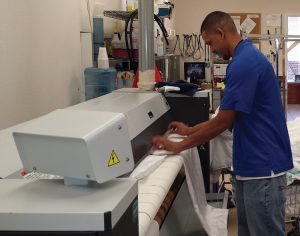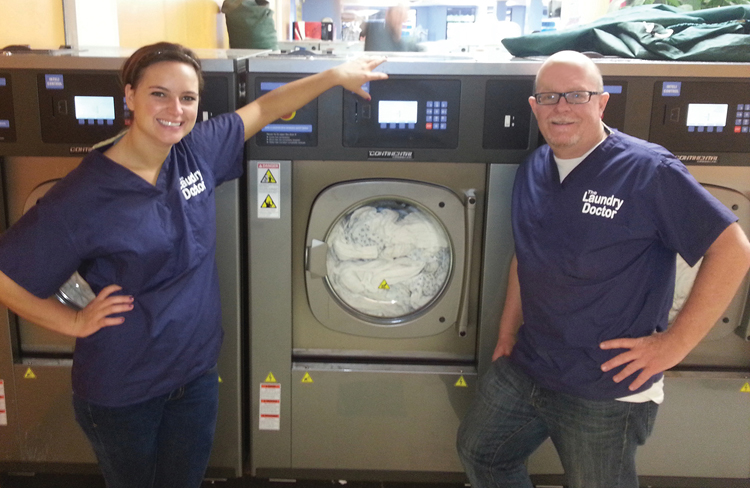A Five-Phase Approach for Developing a Profitable Commercial Laundry Service
As a vended laundry owner, you outlay a lot of money in store development, permitting, construction and equipment. So why not make that investment as fruitful as possible? Fully utilize idle equipment and attendants by launching full-service wash-dry-fold. Then, once you’ve got your head around it, consider adding commercial laundry services to your store’s tagline. Become a retail laundry services enterprise.
The average vended laundry, open 14 to 15 hours daily, utilizes its equipment just 20 percent to 25 percent of the time. The balance – 75 percent to 80 percent – is unrealized capacity and opportunity. Get into that unused capacity, offer more customer services and create additional revenue within your business and asset investment. In the end, you might grow so much that you end up establishing a separate, profitable commercial laundry segment.
Phase 1: Launch Your Wash-Dry-Fold Service
Recent Coin Laundry Association research found that 58 percent of responding laundry owners offer wash-dry-fold services. Of that number, 21 percent provide pickup and delivery. There’s a reason why they do. Wash-dry-fold is an added service, revenue stream and profit center. Do your homework, research wash-dry-fold best practices, become a CLA member – and then develop attendant training, policies and procedures. And, of course, be sure to visit coinlaundry.org for help with this.
Phase 2: Designate Space for Commercial Work
When your wash-dry-fold business has grown to the point that you are competing with self-service customers for equipment, create a designated area within the store for full-service work. At this point, you might be able to get by with the equipment and attendants you already have on-hand. Or, you might need to hire additional attendants for full-service roles and add on-premises washers and dryers. You’ll also require more storage for finished and unfinished product.
If you haven’t already, develop pickup and delivery routes to further expand your service area and revenue.
“Keep in mind that with pickup and delivery routes, you’ll need to stay close to your laundry for best efficiency,” explained Jeff Gardner, president of The Laundry Doctor, based in St. Paul, Minn. “We grew our commercial side too fast, and our accounts and delivery routes were too spread out. Also, try to keep pickup and delivery costs at around 10 to 12 cents per pound. One delivery driver needs to generate $250 per hour to run a profitable business.”
Phase 3: Install On-Premises Washers and Dryers
By adding highly programmable on-premises washers and dryers, you’ll successfully clean just about any item or fabric type. On-premises washers provide automatic chemical injection and more advanced programmability when compared to self-service equipment. Look for on-premises washers that offer multiple baths and rinses; automatic chemical injection; and programmable G-force, mechanical action, water temperatures and cycle times. With appropriately sized equipment, your laundry can pursue commercial accounts that include salons and spas, B&Bs, small hotels, high schools, childcare centers, restaurants, clinics, and more.
Gardner expanded into commercial work from residential wash-dry-fold. In the beginning, his staff kept pace.
“But, at a certain point,” he noted, “I had to expand and hire staff to handle just the commercial side of the business – leaving laundry attendants to help out self-service customers.”
Ultimately, he also added one 90-pound on-premises washer and three 40-pound on-premises units.
“It’s hard to properly clean food and beverage items using a public coin washer, because there should be breaks in between chemical baths, and items require extreme water temperatures,” he said. “I needed a fully programmable washer with hundreds of on-premises programming options.”
Vended washers can’t reach the elevated water temperatures required to eliminate oils and grease. They also can’t offer the necessary programmability. In Gardner’s commercial business, he uses a variety of wash programs. One is for delicate items, such as wedding dresses and delicate linens; that program uses very little mechanical action, 130-degree water temperatures and an enzyme wash that lasts up to two hours. He also has programs in place for heavy soil, with water temperatures reaching 180 degrees, and for washing bulky walk-off mats and blankets.
“Massage linens have oils in them, and you can’t get them clean at traditional laundry temperatures,” Gardner explained. “But using my on-premises washers, we can get the stains and oils out every time with the right program, water temperature and chemicals. Before we got these machines, we couldn’t touch food and beverage laundry. Now, we get it really clean.”
Phase 4: Add a Flatwork Ironer – And Open the Commercial Laundry Floodgates
 Once you’ve got the on-premises washer and dryer, consider adding a flatwork ironer to further catapult your customer and account opportunities. With such an ironer, your business now can quickly iron bed and table linens, making your laundry service attractive to healthcare, food and beverage, and hospitality clients. The flatwork ironer will help you get your foot in the door with previously unserviceable clients (because, in the past, you couldn’t iron their linens). And, soon, you’ll likely end up taking on more than those clients’ ironed sheets and table linens; you’ll be processing their towels and robes as well.
Once you’ve got the on-premises washer and dryer, consider adding a flatwork ironer to further catapult your customer and account opportunities. With such an ironer, your business now can quickly iron bed and table linens, making your laundry service attractive to healthcare, food and beverage, and hospitality clients. The flatwork ironer will help you get your foot in the door with previously unserviceable clients (because, in the past, you couldn’t iron their linens). And, soon, you’ll likely end up taking on more than those clients’ ironed sheets and table linens; you’ll be processing their towels and robes as well.
Gardner pointed out that his ability to iron sheets and pillowcases led directly to sales growth. In fact, he currently processes 200 sheets per hour using his 13-inch flatwork ironer.
“That single piece of equipment allowed me to do work for massage therapists, spas and acupuncturists,” he said. “They started talking about my business to friends. Then business boomed. The ironer paid for itself the first year. Now it pays for itself every month.”
Phase 5: Establish a Plant for Commercial Laundry
Once you’ve outgrown your designated full-service space, thanks to your business’ growing productivity, consider outfitting a separate building with everything you need to serve current and future customers. That’s what many laundry operators end up doing. They establish, grow, invest and expand. Ultimately, like Gardner, they find themselves managing multiple, extremely profitable businesses.
Over the next three years, Gardner said he expects to do the same.
“We are looking to expand into a new plant, equipped with on-premises washers, dryers and our original Continental ironer,” he said. “We likely will bring in another higher volume ironer and folding system as well.”












